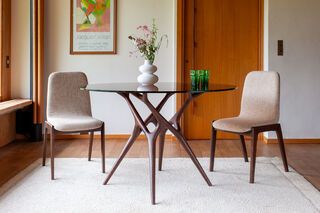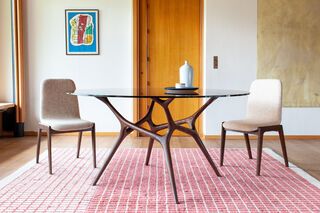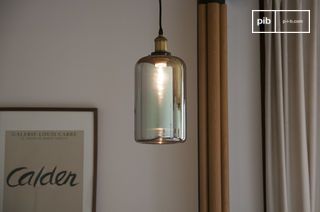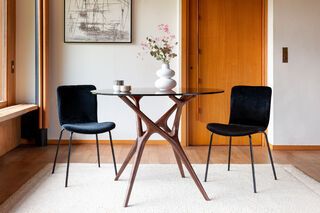Tinted glass
The Tinted Glass category brings together furniture designed with colored glass surfaces, treated to partially filter light. Used on trays, doors or storage modules, tinted glass introduces transparency without losing visual density. Depending on the tint, it modifies the perception of depth or mass. Each piece selected plays on the interplay between material, color and reflection to structure space in a legible way, without weighing down volumes.
read more >Filters

Tinted glass: an intermediate surface between opacity and transparency
Tinted glass intervenes in furniture as a hybrid material. It allows us to see partially through while marking a physical boundary. This ambivalence is useful for table tops, cabinet doors or low partitions. It reduces the direct view of the contents or floor, while allowing light to circulate. Depending on its thickness, tint and gloss level, tinted glass modifies the perception of the object: diffuse presence or structured mass. This property makes it a precise tool for managing the effects of depth or visual clutter in a room.
Choice of tints and impact on the lighting environment
The color of tinted glass influences the way it absorbs or diffuses light. Grey or bronze smoked glass attenuates reflections and creates a slightly reflective surface. Stronger colored glass (green, dark blue) darkens the objects it covers even more, while introducing a tonality into the space. The choice of tint depends on the function of the furniture and its positioning. In a brightly lit area, dark tinted glass limits direct reflections. Conversely, lightly tinted clear glass maintains volume legibility while reducing light saturation.
Associating tinted glass with other furniture materials
Tinted glass is often combined with metal structures or dark wood elements. These combinations enhance the legibility of lines while stabilizing the composition. In a light environment, tinted glass creates a moderate contrast without a sharp break. It can also serve as a link between several materials, introducing a semi-transparent zone that visually lightens a block or façade. The absence of total opacity avoids a mass effect, while maintaining a partial partitioning function. This logic makes tinted glass particularly suitable for intermediate or multifunctional furniture.
The *Tinted Glass* category brings together furniture where this material is used for its spatial potential: modulating light, articulating functions and adjusting visual density without adding opacity or overload.



